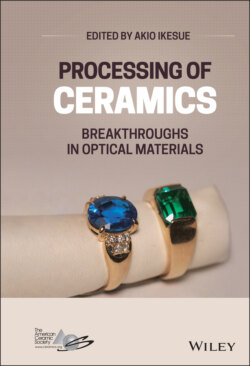Читать книгу Processing of Ceramics - Группа авторов - Страница 22
2.3 Laser Ceramics 2.3.1 Synthesis of Garnet‐Based Materials
ОглавлениеRepresentative examples and flow diagram of the production of Nd:YAG ceramics are shown in Figure 2.3. α‐Al2O3, Y2O3, and Nd2O3 (purity: >99.99%) with a particle size of 0.3, 0.05, and 0.5 μm were used as starting powder materials. About 0.5% TEOS (Tetra Ethel Ortho Silicate), an organic binder, and ethanol solvent were added to these powders and ball‐milled for 12 hours using high‐purity Al2O3 balls (purity: >99.9%) [1]. The obtained slurry was spray‐dried using a spray dryer to obtain granules of approximately 30 μm. The granules were placed in a metal mold, uniaxially pressed at 10 MPa, and further subjected to CIP (Cold Isostatic Press) machine at a pressure of 147 MPa. The molded powder compact was calcined at 800 °C for three hours and then preliminarily sintered at 1500 °C for two hours under a vacuum of 1 × 10−3 Pa. Finally, it was heat‐treated in the capsulated‐free HIP (Hot Isostatic Press, 198 MPa with Ar gas) machine at 1700 °C for two hours to obtain a transparent body.
Figure 2.3 Fabrication flow sheet of Nd:YAG ceramics.
By the way, we synthesize materials by mixing oxides of constituent elements and then reacting them by reactive sintering. Reactive sintering tends to be non‐uniform in composition and has been considered unsuitable for the development of high‐quality ceramics. Until now, high‐quality ceramics such as TYZ (Y2O3 stabilized ZrO2), Tb3Fe5O12, Yb:CaF2 have been developed using raw material powders that have been chemically homogenized using the coprecipitation method or the alkoxide method [2–4]. It is one method of material synthesis to prepare a sintered body with excellent homogeneity by using highly uniform powder obtained by the coprecipitation method. The coprecipitation method as a method of obtaining high‐quality material is widely known, and the above materials have been synthesized using this method from the 1980s. Even with this method, it is possible to produce a laser gain medium capable of laser oscillation. However, the synthesis of raw materials is complicated i.e., when synthesizing ceramic materials of various compositions, the target product cannot be synthesized unless the corresponding raw material powders are synthesized. Another problem that it is difficult to correct the composition (materials with a stoichiometric composition such as garnet cannot have a slight compositional variation because its solid solubility limit is very sharp and narrow) and hence, the production cost is very high.
On the other hand, high‐grade Nd:YAG ceramics could be prepared by reactive sintering method without using such a complicated synthesis. This fact is also contrary to the technical background in the synthesis method and the conventional development philosophy. However, the result is a fact, the powder obtained by the above‐mentioned wet synthesis is complicated and expensive, and the reactive sintering method is an extremely simple and low‐cost synthetic process obtained by mixing oxides of constituent elements. These are the advantages of the dry process. The sintered body obtained by the HIP treatment is machined to the required shape, and the input and output surfaces of the sample are optically polished into laser grade; basically, flatness λ/10 (λ = 633 nm), micro‐roughness Rms = 0.3 nm, and parallelism = 10 seconds. These samples are used for optical measurement and laser oscillation tests.
